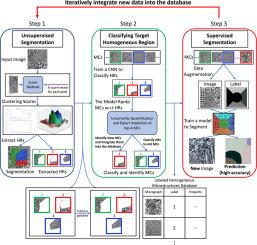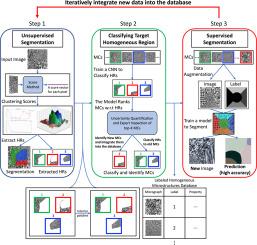材料微观结构图像的监督与非监督分割与分类框架
IF 9.3
1区 材料科学
Q1 MATERIALS SCIENCE, MULTIDISCIPLINARY
引用次数: 0
摘要
材料的微观结构通常通过图像分析来表征,以了解加工-结构-性能之间的联系。我们提出了一个很大程度上自动化的框架,集成了无监督和有监督的学习方法,根据微观结构的相/类对显微照片进行分类,对于多相微观结构,将它们分割成不同的均匀区域。随着制造和成像技术的进步,超高分辨率的成像技术揭示了微观结构的复杂性,图像(即显微照片)的数量迅速增加,使得并且需要一个更强大和自动化的框架来提取材料特征和知识。我们提出的框架可以用来逐步建立一个与特定工艺或材料组相关的微观结构类数据库,这有助于分析和发现/识别新材料。该框架分为三个步骤:(1)对多相显微图进行初步分割,以无监督的方式识别不同的微观结构均匀区域;(2)使用步骤1中分割的显微图训练的不确定性感知监督分类网络,并通过内置不确定度量化和最少的人工检查验证其识别标签,对显微图的均匀区域进行识别和分类;(3)使用一种数据增强的形式,通过使用显微照片和步骤1-2的结果训练的分割网络,对多相微结构进行后续监督分割(比步骤1中的分割更强大)。该框架可以迭代地描述/分割新的同质或多相材料,同时扩展数据库以提高性能。该框架在多组材料和纹理图像上进行了演示。本文章由计算机程序翻译,如有差异,请以英文原文为准。


A framework for supervised and unsupervised segmentation and classification of materials microstructure images
Microstructure of materials is often characterized through image analysis to understand processing-structure-properties linkages. We propose a largely automated framework that integrates unsupervised and supervised learning methods to classify micrographs according to microstructure phase/class and, for multiphase microstructures, segments them into different homogeneous regions. With the advance of manufacturing and imaging techniques, the ultra-high resolution of imaging that reveals the complexity of microstructures and the rapidly increasing quantity of images (i.e., micrographs) enables and necessitates a more powerful and automated framework to extract material characteristics and knowledge. The framework we propose can be used to gradually build a database of microstructure classes relevant to a particular process or group of materials, which can help in analyzing and discovering/identifying new materials. The framework has three steps: (1) preliminary, segmentation of multiphase micrographs so that different microstructure homogeneous regions can be identified in an unsupervised manner; (2) identification and classification of homogeneous regions of micrographs through an uncertainty-aware supervised classification network trained using the segmented micrographs from Step 1 with their identified labels verified via the built-in uncertainty quantification and minimal human inspection; (3) subsequent supervised segmentation (more powerful than the segmentation in Step 1) of multiphase microstructures through a segmentation network trained with micrographs and the results from Steps 1–2 using a form of data augmentation. This framework can iteratively characterize/segment new homogeneous or multiphase materials while expanding the database to enhance performance. The framework is demonstrated on various sets of materials and texture images.
求助全文
通过发布文献求助,成功后即可免费获取论文全文。
去求助
来源期刊

Acta Materialia
工程技术-材料科学:综合
CiteScore
16.10
自引率
8.50%
发文量
801
审稿时长
53 days
期刊介绍:
Acta Materialia serves as a platform for publishing full-length, original papers and commissioned overviews that contribute to a profound understanding of the correlation between the processing, structure, and properties of inorganic materials. The journal seeks papers with high impact potential or those that significantly propel the field forward. The scope includes the atomic and molecular arrangements, chemical and electronic structures, and microstructure of materials, focusing on their mechanical or functional behavior across all length scales, including nanostructures.
 求助内容:
求助内容: 应助结果提醒方式:
应助结果提醒方式:


